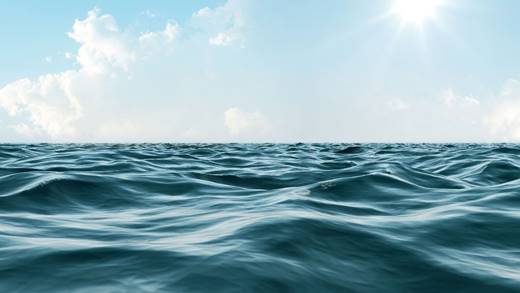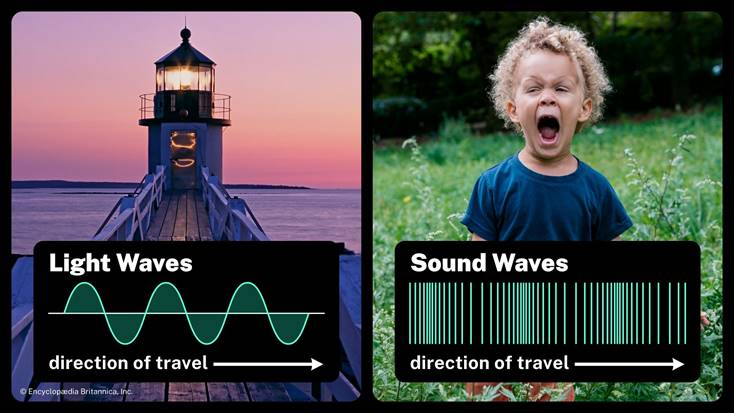What are
Waves?
Learning
Objectives
By the end of this unit, you will be able to
understand the fundamental principles of waves, including their nature as
patterns of motion that transfer energy through a medium. You will be able to
differentiate between different types of waves, such as water waves, light
waves, and sound waves, and explain their unique characteristics and
properties. You will also grasp the concept of energy transfer through waves
and recognize the significance of waves in various natural phenomena.

Deep
ocean waves have a regular pattern. They are just one
example of a type of wave.
©
bombybamby/stock.adobe.com
Lesson
Summary
This lesson introduces you to the concept of
waves, the patterns of motion that move energy from one place to another. The
lesson provides a basic overview and explanation of waves and energy through
video, diagrams, photos, and text. Examples include water, light, and sound.

As
this girl plays the guitar, sound waves are produced. The waves travel away
from their source in all directions.
Illustration:
Encyclopædia Britannica, Inc.
Key Concepts
1. Waves are patterns of motion that carry energy from one place to
another through a medium without
transporting matter itself.
2. Disturbances on the
water's surface form water waves and
consist of crests and troughs. They transfer energy and can be observed in
oceans, lakes, and bathtubs.
3. Light waves are electromagnetic radiation that allows us
to see the world. They can travel through space and transparent materials,
carrying energy and exhibiting properties like wavelength and frequency.
4. Sound waves are responsible for the sounds we hear and are
produced by vibrations in a medium, usually air. They propagate through
compressions and rarefactions, and their properties include frequency and
amplitude.
5. Waves can transfer energy from one location to
another without physically displacing the medium. They play a crucial role in
natural phenomena such as ocean waves, color perception, and sound
transmission.

Light waves and sound waves have different
patterns, but both transfer energy.
Illustration:
Encyclopædia Britannica, Inc
Background
In the world around us, many amazing phenomena
involve the movement of energy. One fascinating concept is that of waves, which
are patterns of motion that carry energy from one place to another. Waves can
be found in various forms, such as water, light, and sound. In this lesson, we
will explore the basic principles of waves and learn how they transfer energy.

This girl is using the Sun's energy to help
her see her tablet.
©
Flamingo Images/stock.adobe.com
A wave can be considered a disturbance or
vibration that travels through a medium, a solid, a liquid, or a gas. Waves
transfer energy without actually transporting matter. Instead, they move
through a medium, causing particles or fields to vibrate or oscillate.
Types of Waves:
There are different types of waves, each with
its unique characteristics. Let's take a closer look at three examples: water
waves, light waves, and sound waves.
1. Water Waves: Water waves are commonly observed in oceans,
lakes, and bathtubs. They are created by disturbances on the water's surface,
such as wind blowing or an object being dropped into it. Water waves consist of
a series of crests (the highest points) and troughs (the lowest points). As the
waves move, they transfer energy from one location to another.
2. Light Waves: Light waves allow us to see the world around
us. They are a form of electromagnetic radiation consisting of electric and
magnetic fields that oscillate perpendicularly. Light waves can travel through
space and transparent materials like air, water, and glass. They carry energy
and have different properties, including wavelength and frequency, determining
their color.
3. Sound Waves: Sound waves are responsible for the sounds we
hear. They are produced by vibrations or oscillations in a medium, usually air
molecules. When an object vibrates, it creates compressions (areas of higher
pressure) and rarefactions (areas of lower pressure) in the air. These pressure
changes then propagate as sound waves. Sound waves have properties such as
frequency (which determines pitch) and amplitude (which determines volume).
One of the essential characteristics of waves
is their ability to transfer energy
from one place to another. As waves propagate through a medium, they transfer energy without physically displacing the
medium itself. For example, ocean waves carry energy from the ocean's surface
to the shore, light waves transfer energy from the Sun to Earth, and sound
waves transmit energy from a source to our ears.

Compare the two lamps. Although they both
give off light, there are some differences.
(Left)
© Africa Studio/stock.adobe.com; (Right) © Carmen Jiménez—EyeEm/Getty
Images
Understanding the concept of waves is crucial
for comprehending various natural phenomena. Whether it's the movement of ocean
waves, the colors we see, or the sounds we hear, waves play a significant role
in transferring energy from one location to another. By studying waves, we can
unravel the world's mysteries and appreciate the remarkable patterns of motion
that surround us every day.
Expedition
Learn
Click on the image to begin your unit.
